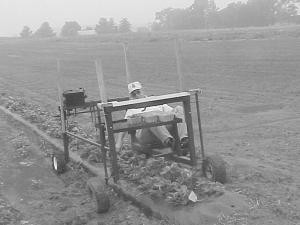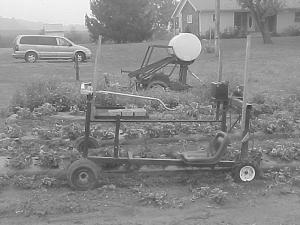2006 - Volume #30, Issue #3, Page #33
[ Sample Stories From This Issue | List of All Stories In This Issue | Print this story
| Read this issue]
Sit-Down Cart Makes Strawberry Pick'n Easy
 |
 |
"It's better than bending," says Brown, who knows a lot about bending. With his wife Marcia, he produced 10,000 quarts of strawberries on their berry farm in 2004. They also sold 2,500 pints of black raspberries, 500 pints of red raspberries and 3,000 pints of blueberries.
Brown had once tried a three-wheel pedal cart, but found it difficult to steer. With his new cart, all he has to do is flip a toggle switch to go forward or back or leave it in the middle to stop.
The cart consists of a 4 by 6-ft. frame, a 12-volt gear reduction motor, and the battery it runs off. The frame is made from 3 by 3-in. steel tubing. At the front and rear, two uprights about 3 ft. high are connected at the top by a cross beam with wheels mounted on the other ends. Two 6-ft. side rails connect the front and rear ends. One side rail mounts at about the 2-ft. height, while the other is only 12 in. above the ground and hosts the operator seat. An expanded metal rack for setting filled containers is mounted just ahead of the operator. It is attached to the front posts and rests on a leg attached to the left side rail.
The motor and battery are attached to the rear cross rail. A roller chain connects the motor to a sprocket on the drive shaft. The drive shaft extends through bearings on the two rear uprights and is capped with sprockets at each end. Initially, roller chains from these sprockets drove sprockets on the rear wheel spindles mounted between the wheels and the uprights.
"Without a differential, a chain would jump off the outside sprocket every time I turned," says Brown. "I found that powering just the wheel behind my seat was enough."
To steer the rig, Brown recycled an old garden tractor's tie rod and steering gear mechanism, including the front wheels, and adapted it to fit the front end of the frame. The tie rods extend the width of the cart.
Vertical rods attach to the front wheel spindles through braces welded to the base of the front uprights and again through a plate at their top. A short arm connects the vertical rods to the tie rods. To steer the tractor, Brown simply moves a steering lever, connected to the arm on the operator's side of the frame, to the right or left.
For protection from rain and sun, Brown mounted 1 by 2-in. wood extensions on the four upright wheel posts. Two 6-ft. 2 by 4s mounted to the wood uprights provide a base to stretch a plastic sheet for a canopy.
Contact: FARM SHOW Followup, Tim Brown, Brownvalley Farms, 295 Hickory Rd, Littlestown, Penn. 17340 (ph 717 359-5084; brownvalley@supernet.com).

Click here to download page story appeared in.

Click here to read entire issue
To read the rest of this story, download this issue below or click here to register with your account number.




